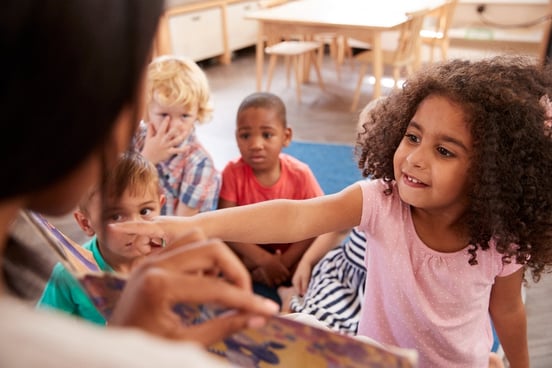STEMscopes Staff | Published January 24, 2023
Games are highly motivating for everyone, including students. But you don’t have to turn your classroom into a game show or a video arcade to reap the benefits. Learn about the benefits of using both Game-based learning and Gamification in your classroom.

Games, like education, have been part of human civilization since the very beginning, and the connection between the two also has ancient roots. Games have always been a way for children to practice essential skills and learn about the world around them.
Likewise, teachers have always found ways to integrate learning and games, from using dice to generate random numbers, to having students play or even design content-themed board games, to using classroom Jeopardy to review important concepts.
As games have advanced with technology, so have the opportunities to utilize new formats, such as computer/video games, simulations, etc., in educational settings.
Very few teachers have the skills and time to develop a video game to help kids learn essential skills and knowledge. Many won’t even be able to find one. Some teachers aren’t comfortable letting students play games in class, fearing it distracts them from “real” learning.
No matter what your skill set or comfort level, there are ways for all teachers to use gamification and game-based learning effectively.
The simplest definition of gamification is the application of game elements to a nongame environment (Deterding et al., 2011).
An example of this would be the punch card you get at the coffee shop that gives you your tenth latte free. When applied to the classroom, this could mean awarding prizes for attendance or high scores. The emphasis is on extrinsic motivation, and often there is no organic connection between the reward and the learning.
We shouldn’t assume, however, that gamification has no place in the classroom.
Some behaviors we need students to perform aren’t intrinsically motivating, and gamification can provide the push kids need.
Besides, gamification can add a layer of excitement to routine activities.
Kahoot, one of the most popular web-based gamification sites, provides resources for classroom teachers that include interactive games for introducing, reviewing, and assessing content.
For the classroom teacher who likes to keep it old school, you can also find STEM-themed board games. Of course, there’s no need to choose. A complete and well-balanced STEM curriculum, like STEMscopes, will include computer-based resources such as games and simulations, as well as opportunities to engage in hands-on game-like activities.
While gamification is a system of techniques that stresses extrinsic motivation, game-based learning (GBL) is more of a philosophy, an approach to classroom design that emphasizes intrinsic motivation.
Think about it. Although many games offer prizes, we play without the need for an external reward. We keep playing games even when we lose. Why? We play because games provide intrinsic rewards. Games are fun in and of themselves.
Video games are uniquely popular at present and a clear example of something kids will spend hours doing, but all games, including card games, board games, and team sports, use the same principles that make them intrinsically motivating. Teachers can apply these same principles to the learning environment.
The first chapter of Teaching in the Game-Based Classroom (Seelow, 2022), a book I highly recommend, provides Ten Principles to Make School a Better Game. Let’s explore how five of these principles make games fun and how they can be applied to a STEM classroom. (Fair warning, most of my game references are somewhat dated.)

Think about the first time you played a video game. How did you know what to do? On the opening screen of Donkey Kong, without any instructions, it’s pretty clear what the goal is. Climb the ramps and save the princess.
Also, the goal, it is important to note, remains visible throughout the game. You always know where you’re going. The same principle applies to a classroom. Students are more likely to pursue a goal if they understand it clearly and can continuously monitor their progress.
The best games allow players to decide their path, sometimes quite literally. The maze in Pac-Man is a perfect example.
Games are enjoyable when there is an element of strategy. Players can try different approaches to see what works, and more than one strategy can be successful.
Students are diverse, and even the same student can change over time. Classrooms that support student autonomy and provide multiple paths to success are more likely to engage and motivate all students.
Many games appeal to us because they allow us to be part of a team. Sports are a classic example, but card games and board games also use teamwork as a motivating factor.
Video games also take advantage of the appeal of teamwork. The development of online gaming platforms has resulted in multi-player games with vast numbers of players.
These Massive Multi-Player Online games (MMOs like World of Warcraft and Fortnite) allow for interaction and collaboration with players from all over the world. A classroom that encourages a truly collaborative community of learners takes advantage of this principle.
It’s easy to get frustrated when trying something new. The best games provide easy successes early on. The smallest sluggers play t-ball before they have to face a pitcher.
Level 1 of Super Mario Brothers is much easier than Level 32. As players progress, good games offer a series of slightly more difficult challenges, just beyond the player’s ability, allowing them to practice new skills, improve, and move up.
This principle fits nicely with Vygotsky’s Zone of Proximal Development (Vygotsky, 1967), the concept that learning takes place right at the edge of what a student can do presently. Learners are motivated when they are neither frustrated by work that is too hard nor bored by work that is too easy and when they can see their skills improving.
In a classroom, this means not only finding the right level of work for students but also making them aware of where they are in developing their skills.
Sports offer the best demonstration of how productive failure (closely related to productive struggle) can be both motivating and instructive. A single baseball game gives each player many chances for failure, but what makes a failure productive?
A strike, for example, is a productive failure when it pushes the batter to focus on what went wrong and try again, improving their technique. In most video games, the player starts with at least three “lives.” This reduces the stress of losing one and lets the player relax and learn from their mistakes. A grading system that allows students to drop their lowest scores is one way to use this principle in a classroom.
Beyond simple techniques, the principle of productive failure is expressed in a classroom where the general attitude acknowledges that failure is unavoidable and encourages students to use it as an opportunity for learning and growth.
The information presented here is just an introduction to gamification and game-based learning. Many readers will recognize that they already use some forms of gamification or that their classroom instruction currently reflects one or more principles of GBL.
For others, some of this information will be new. In either case, you will hopefully be inspired to learn more about both and try to implement what you learn. As you do, you can apply the GBL principles to your own learning.
Set clear goals for yourself in terms of adding gamification or GBL, and constantly monitor your progress so you can give yourself credit for growth.
Start with the easy stuff so that you can score some early successes. Just as importantly, acknowledge that there will be failure; just make sure it’s productive failure by reflecting on how you can learn and improve.
You can also create a sense of belonging by connecting with other teachers interested in gamification and GBL. You could find colleagues in your school or district or join a national group like the Game-Based Learning Alliance.
Just like learning to play a new game or mastering a sport, with the application of strategy, and a little luck, you will reach your goal and have fun doing it!
References
Deterding, S., Dixon, D., Khaled, R., & Nacke, L. (2011, September). From game design elements to gamefulness: defining" gamification." In Proceedings of the 15th international academic MindTrek conference: Envisioning future media environments (pp. 9–15).
Seelow, D. (2022). Teaching in the game-based classroom: Practical strategies for grades 6-12. Routledge.
Vygotsky, L. S. (1967). Play and its role in the mental development of the child. Soviet psychology, 5(3), 6-18.

At the start of the school year, teachers have the chance to create a math classroom where every student feels valued...

Math manipulatives are a great way to make math more accessible for your students, especially if you know they may...

Storytelling is one of the oldest forms of communication as a way to share experiences, understand others, and...